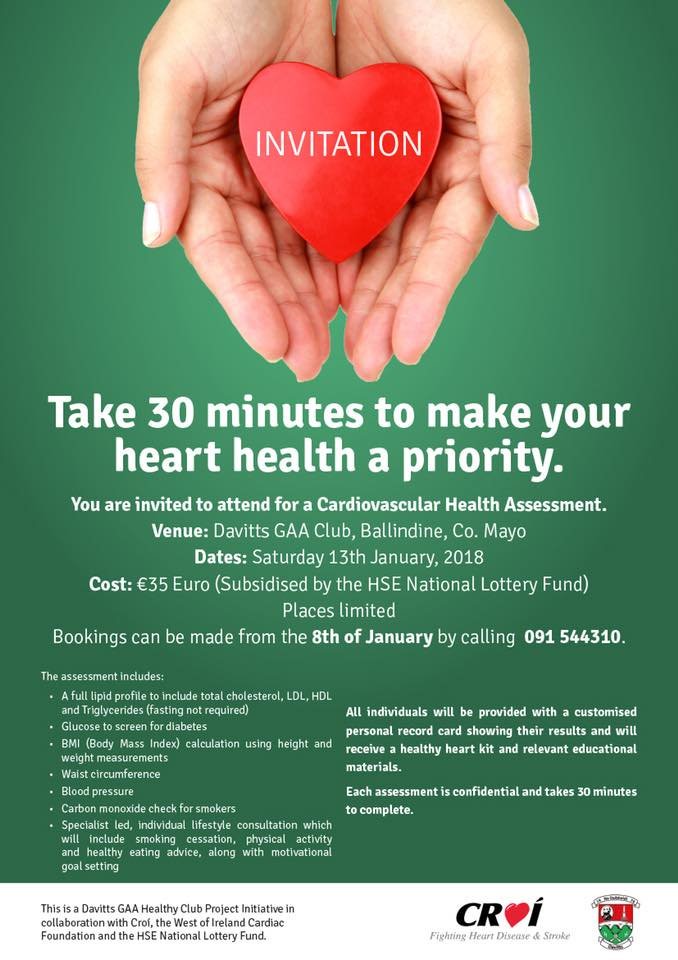Feasacht Sláinte: Irish Medical Students’ Perspective on the Importance of Anatomy and Physiology for the Irish Public
J.L. Jeger*, T.K. Samson*, D.S. Barry
*Joint First-Authorship
Department of Anatomy, Trinity College Dublin, College Green, Dublin 2
Dear Editor,
In 2016, the total Irish healthcare expenditure equaled €20.332 billion, of which €666 million was spent on preventative care, including community oriented information and education campaigns 1. Amongst others, recent campaigns such as Restart a Heart, Cardiovascular Health Assessment, and QUIT have targeted cardiovascular and pulmonary health awareness (see Figures 1 and 2) to improve population health and promote early intervention.
Figure 1: Invitation for a Cardiovascular Health Assessment Co. Mayo
Figure 2: Irish Heart Foundation Campaign for Blanket Ban on Junk Food Advertising
The success of these campaigns is in part reliant on public understanding of basic human anatomy and clinical signs. However, the Irish public may be less aware of basic human anatomy and physiology than one may expect. In countries such as the UK, US, Portugal, Brazil, Jordan, Turkey, and Namibia studies have shown that the general public’s understanding is limited as it relates to general anatomy, reproductive physiology, cervical health, cardiovascular disease, and other topics 3, 4. In Ireland, however, no such studies have been reported. As such, it remains unknown to what extent the public is aware of their own surface anatomy or disease processes. As second year medical students, we recently experienced first-hand how much a basic understanding of human anatomy and physiology can change one’s outlook on health and disease. As such, we hypothesize that gaining a basic understanding of these topics can have an impact on health outcomes for the general population.
A study addressing this gap in knowledge would provide insight into the extent of the public’s anatomical and physiological understanding. This information would shed light on whether the Irish education system or other societal sources sufficiently address these topics. This anatomical and physiological understanding may guide individuals to make educated decisions with regard to their own health and healthcare, such as when to call an ambulance or go to their GP. A 2013 UK study found that diabetic individuals who took part in patient education found the experience to be “life changingly positive” 2. A better understanding of the public’s knowledge could also help guide physicians’ interactions with patients. Additionally, such a study could provide valuable information on how Ireland compares to the rest of the world.
Studies in the UK, Ireland’s closest neighbor, have shown that the public does in fact lack basic anatomical understanding such as location and function of the pancreas, kidneys, and other anatomical structures; however, it was also shown that the public is eager to gain a better understanding of their own anatomy 3, 4. The goal of this proposed study is to highlight this gap in our health care knowledge base and health awareness strategies.
Sincerely,
The Authors
Corresponding Author
Dr. Denis Barry
Trinity Biomedical Sciences Institute,
Trinity College Dublin,
Dublin 2
Email: [email protected]
Phone: 01 8961793
References
1. Central Statistics Office. System of Health Accounts2018 October 15, 2018 [cited 2018 15 October]:[12 p.].
2. Snow R, Humphrey C, Sandall J. What happens when patients know more than their doctors? Experiences of health interactions after diabetes patient education: a qualitative patient-led study. BMJ Open. 2013;3(11).
3. Weinman J, Yusuf G, Berks R, Rayner S, Petrie KJ. How accurate is patients’ anatomical knowledge: a cross-sectional, questionnaire study of six patient groups and a general public sample. BMC Family Practice. 2009;10:43-.
4. Taylor AM, Diggle P, Wessels Q. What do the public know about anatomy? Anatomy education to the public and the implications. Anatomical Sciences Education. 2018;11(2):117-23.
Issue: Ir Med J; Vol 112; No. 6; P961


